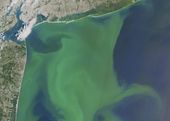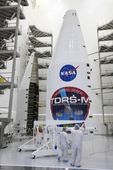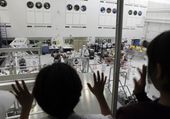NASA
Latest Stories

climate_choked_water_91037.jpg
In this image provided by NASA, taken Aug. 3, 2015, phytoplankton is seen off the coast of New York, top and New Jersey, left. A new study projects that global warming’s increased rains will mean more nitrogen flowing into U.S. waterways, which can then trigger more massive blooms of algae, floating green mats, and dead zones with almost no oxygen. This handout NASA satellite photo shows a large bloom of phytoplankton off the New York and New Jersey coast in August 2015. (NASA via AP)

satellite_damaged_53134.jpg
FILE - In this July 13, 2017, file photo provided by NASA, the payload fairing for NASA's Tracking and Data Relay Satellite, TDRS-M, is inspected prior to encapsulating the spacecraft, inside the Astrotech facility in Titusville, Fla. One of the antennas on the Tracking and Data Relay Satellite ended up broken earlier this month during final launch preps causing NASA to delay the launch by more than two weeks. Liftoff is now targeted for Aug. 20 from Cape Canaveral, Fla. (Glenn Benson/NASA via AP, File)

travel_pasadena_81186.jpg
FILE - In this April 4, 2011, file photo, school children look from a viewing gallery at NASA engineers working on the rover Curiosity at the Mars Science Laboratory, at the Jet Propulsion Laboratory in Pasadena, Calif. (AP Photo/Damian Dovarganes, File)

satellite_damaged_48287.jpg
In a July 13, 2017 photo provided by NASA, the payload fairing for NASA's Tracking and Data Relay Satellite, TDRS-M, is inspected prior to encapsulating the spacecraft, inside the Astrotech facility in Titusville, Fla. NASA said Monday, July 17, 2017, that one of the antennas on the Tracking and Data Relay Satellite, was damaged last Friday. The mishap could delay what was supposed to be an Aug. 3 liftoff aboard an Atlas V (five) rocket. (Glenn Benson/NASA via AP)

astronauts_water_training_83434.jpg
In this Thursday, July 13, 2017 photo, NASA astronaut Suni Williams, second from right, looks out over the Gulf of Mexico where testing of the Orion capsule is taking place about four miles off of Galveston Island, Texas. The testing is the first time since the Apollo program that NASA has practiced such egress techniques from a capsule in open water. (Mark Mulligan/Houston Chronicle via AP)

astronauts_water_training_40726.jpg
In this Thursday, July 13, 2017 photo, with assistance from the U.S. Coast Guard and support staff, NASA Astronauts Daniel Burbank, Stanley Love, Mike Fincke and Victor Glover practice egress techniques from NASA's new Orion capsule about four miles off of Galveston Island, Texas, in the Gulf of Mexico. The testing is the first time since the Apollo program that NASA has practiced such egress techniques from a capsule in open water. (Mark Mulligan/Houston Chronicle via AP)

astronauts_water_training_88119.jpg
In this Thursday, July 13, 2017 photo, NASA astronaut Mike Fincke jumps into a life raft from an Orion capsule the astronauts are using for a recovery test about four miles off of Galveston Island, Texas in the Gulf of Mexico. The testing is the first time since the Apollo program that NASA has practiced such egress techniques from a capsule in open water. (Mark Mulligan/Houston Chronicle via AP)

astronauts_water_training_68024.jpg
In this Thursday, July 13, 2017 photo, NASA astronaut Victor Glover jumps into the Gulf of Mexico while practicing an emergency egress situation aboard the Orion capsule they are using for recovery testing about four miles off of Galveston Island, Texas. The testing is the first time since the Apollo program that NASA has practiced such egress techniques from a capsule in open water. (Mark Mulligan/Houston Chronicle via AP)

astronauts_water_training_42028.jpg
In this Thursday, July 13, 2017 photo, NASA astronaut Victor Glover signals back up to astronaut Daniel Burbank that he is OK after jumping into the Gulf of Mexico from the Orion capsule the astronauts are using to practice an emergency egress situation during recovery testing about four miles off of Galveston Island, Texas. The testing is the first time since the Apollo program that NASA has practiced such egress techniques from a capsule in open water. (Mark Mulligan/Houston Chronicle via AP)

space_jupiter_23478.jpg
This enhanced-color image made available by NASA shows Jupiter's Great Red Spot on Monday, July 10, 2017. The image was created using data from the Juno spacecraft during its seventh close flyby of the planet. (Seán Doran/Gerald Eichstädt/MSSS/SwRI/NASA via AP)

antarctica_iceberg_67181.jpg
This Nov. 10, 2016 aerial photo released by NASA, shows a rift in the Antarctic Peninsula's Larsen C ice shelf. A vast iceberg with twice the volume of Lake Erie has broken off from a key floating ice shelf in Antarctica, scientists said Wednesday July 12, 2017 . The iceberg broke off from the Larsen C ice shelf, scientists at the University of Swansea in Britain said. The iceberg, which is likely to be named A68, is described as weighing 1 trillion tons (1.12 trillion U.S. tons).(John Sonntag/NASA via AP)

Antarctica_Iceberg_67181.jpg-98971.jpg
This Nov. 10, 2016 aerial photo released by NASA, shows a rift in the Antarctic Peninsula's Larsen C ice shelf. A vast iceberg with twice the volume of Lake Erie has broken off from a key floating ice shelf in Antarctica, scientists said Wednesday July 12, 2017. The iceberg broke off from the Larsen C ice shelf, scientists at the University of Swansea in Britain said. The iceberg, which is likely to be named A68, is described as weighing 1 trillion tons (1.12 trillion U.S. tons).(John Sonntag/NASA via AP)

new_planets_90163.jpg
This artist rendering provided by NASA/JPL-Caltech/T. Pyle, taken in 2015, depicts one possible appearance of the planet Kepler-452b, the first near-Earth-size world to be found in the habitable zone of a star that is similar to our sun. NASA says its planet-hunting telescope has found 10 new planets outside our solar system that are likely the right size and temperature to potentially have life on them. (NASA/JPL-Caltech/T. Pyle via AP)

new_astronauts_31037.jpg
Vice President Mike Pence delivers remarks during an event where NASA introduced 12 new astronaut candidates, Wednesday, June 7, 2017, at NASA's Johnson Space Center in Houston, Texas. NASA chose 12 new astronauts Wednesday from its biggest pool of applicants ever, selecting seven men and five women who could one day fly aboard the nation's next generation of spacecraft. (Bill Ingalls/NASA via AP)

new_astronauts_62610.jpg
Vice President Mike Pence delivers remarks during an event where NASA introduced 12 new astronaut candidates, Wednesday, June 7, 2017, at NASA's Johnson Space Center in Houston, Texas. NASA chose 12 new astronauts Wednesday from its biggest pool of applicants ever, selecting seven men and five women who could one day fly aboard the nation's next generation of spacecraft. (Bill Ingalls/NASA via AP)

new_astronauts_19711.jpg
Vice President Mike Pence recognizes the newly introduced 12 new NASA astronaut candidates, Wednesday, June 7, 2017, at NASA's Johnson Space Center in Houston, Texas. NASA chose 12 new astronauts Wednesday from its biggest pool of applicants ever, selecting seven men and five women who could one day fly aboard the nation's next generation of spacecraft. (Bill Ingalls/NASA via AP)

new_astronauts_73142.jpg
Vice President Mike Pence poses for a group photograph with NASA's 12 new astronaut candidates, Wednesday, June 7, 2017, at NASA's Johnson Space Center in Houston, Texas. NASA chose 12 new astronauts Wednesday from its biggest pool of applicants ever, selecting seven men and five women who could one day fly aboard the nation's next generation of spacecraft. (Bill Ingalls/NASA via AP)

new_astronauts_50974.jpg
This undated photo made available by NASA on Wednesday, June 7, 2017 shows the 2017 NASA Astronaut Class at the Johnson Space Center in Houston. From left are Zena Cardman, Jasmin Moghbeli, Jonny Kim, Frank Rubio, Matthew Dominick, Warren Hoburg, Robb Kulin, Kayla Barron, Bob Hines, Raji Chari, Loral O' Hara and Jessica Watkins. (Robert Markowitz/NASA via AP)

space_station_37260.jpg
In this frame from NASA TV, a SpaceX Dragon arrives at the International Space Station on Monday, June 5, 2017, making an unprecedented second trip to the orbiting outpost. The Dragon supply ship, recycled following a 2014 flight, was launched from Florida on Saturday. (NASA TV via AP)

space_station_52490.jpg
In this frame from NASA TV, a SpaceX Dragon approaches the International Space Station on Monday, June 5, 2017, making an unprecedented second trip to the orbiting outpost. The Dragon supply ship, recycled following a 2014 flight, was launched from Florida on Saturday. (NASA TV via AP)


